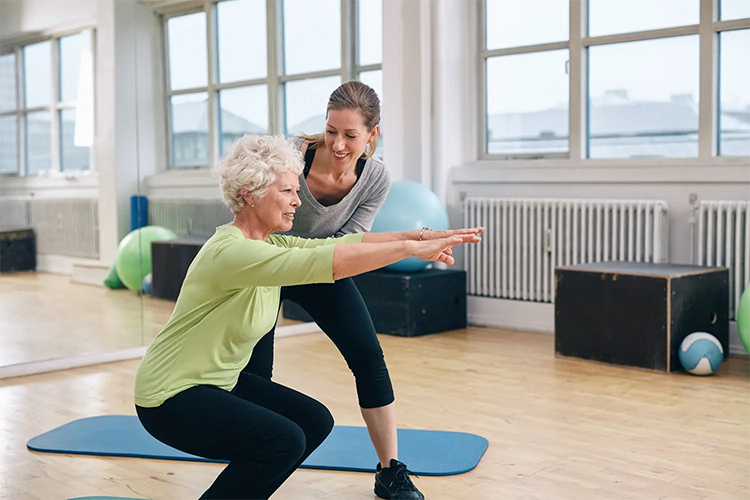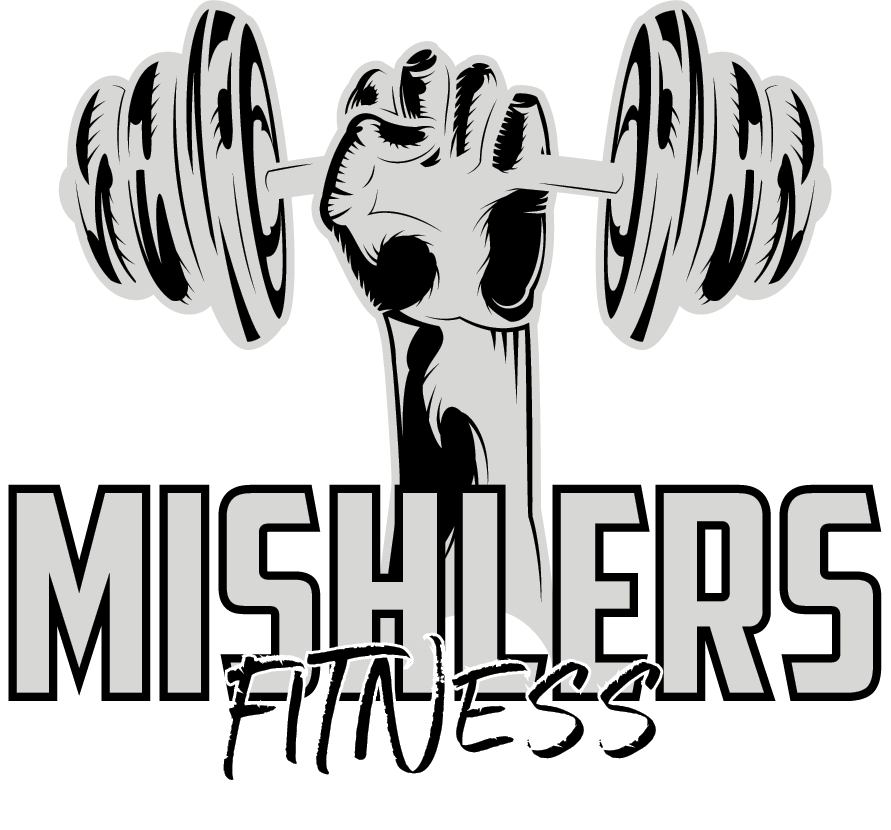Better balance gives you the confidence to be successful with a lot of your daily activities. If you’ve heard me say it once you’ve heard me, say it 1000 times: you are never too late, you are never too old to start improving your health. And a big part of a healthy lifestyle as we age into our senior years is a good balance.
According to the CDC, injuries from falls are the leading cause of injury-related death for Americans 65 and older. One of the main risk factors for falling is poor balance. Luckily, we have pulled together exercises you can do to help reduce the risk of taking a fall. At the end of the day, balance is a big part of graceful aging and being independent.

The Benefits of Balance Exercises for Seniors
Balance is one of those things where you might not realize the importance of it until you start to lose it. And for most of us, this loss comes with old age.
For some seniors, poor balance and falling can stem from medical issues that they have no control of. According to the American Council on Exercise, one in five older adults has issues with balance.
But for a good majority of these folks, it is simply a matter of losing their strength and the natural ability to move the way they did when they were younger because they simply don’t do it anymore. And it only takes one fall to take a senior off their feet for weeks or months or possibly remove their independence completely.
And in case you don’t think you need to take it all that seriously, consider that falls are the leading cause of death from injury among people 65 and older. According to the National Council on Aging falling is NOT an inevitable result of aging. That’s right – you can do your part now to help prevent falling later.
Benefits of balance as you age include:
· Increased reaction time which is good for fall prevention. This is important because one of the easiest ways to stop yourself mid-fall is by quickly shifting your weight or gripping onto an object nearby.
· Improved mobility.
· Better body awareness means awareness of your body in space.
· More independence and self-sufficiency. You’ll have more confidence and a reduced risk of injury.
· Improved coordination.
· Stronger bones and muscles. It is well-documented that exercise helps to build muscle and strengthen bones. Strong bones are more resistant to fractures and reduce the risk for osteoporosis.
· Better vision. Regular exercise can help maintain better eye health and will improve your ability to avoid obstacles that could cause you to fall.
Why Seniors Lose Balance
As a natural part of aging, balance is hindered by factors such as joint degeneration and muscle loss. Weaker core muscles and even changes in eyesight can cause seniors to lose balance more often.
Loss of balance is not inevitable as you age. You do not have to accept it as a given.
The good news is that there are countless ways to improve your balance. Some things are super simple that you can incorporate into your everyday life.
What is Balance
Think of it this way: just like you shouldn’t wait until you are 65 to start thinking about saving money for retirement, you also shouldn’t wait until you are older to prepare your body for the strength and balance you will need to stay independent and strong for as long as possible!
Balance is the ability to maintain your body’s stability in space.
Balance is determined by sensory input from our inner ear and eyes as well as motor feedback from muscles that control the movement of our limbs. Our core muscles are a big part of this. The better we become at processing these signals, the more quickly we can react to keep ourselves balanced.

The Sensory Components of Balance
In order to maintain balance, three senses are used.
Eyes. Your vision offers clues that help you maintain your balance and steer clear of obstacles.
Nerves. Your body has nerve receptors in the canals of your inner ear that send messages to your brain when your head moves in any direction.
Muscles and tendons. The third contributor to good balance is proprioceptors, which tell your brain when you are moving so you know how much muscle shift is necessary to maintain equilibrium.
How Seniors Can Assess Their Balance
These are a few tips for seniors to see where their balance is currently. It’s important to understand your level of balance first before you get started with any type of stretching, balance, or exercise routine.
Determine which leg is your dominant side. Be aware of it as you practice balance. It is normal to have one side be stronger and it’s good to recognize and work on that non-dominant side.
Assess your posture. Often posture can play a major role in overall balance and stability.
Assess your core muscles. They play a huge part in your ability to balance. Learning to engage the core muscles and working on strengthening them will be key to your success.
Gaze at a fixed point on the wall. Finding a focal point when performing exercises can make it easier to balance.
Keep your knees slightly bent. This will lower your center of gravity and will prevent your knees from buckling and make you more stable overall.
Spread your weight evenly across both feet. Wider base, better balance.
What Seniors Can Do to Improve Balance
- Stand on one foot from time to time during the day.
- Sit on an exercise ball at your desk instead of a chair
- Squat one inch over a chair and hold for a few seconds before sitting down.
- Walk with a book on your head. (Old school but effective!)
- Take yoga classes!
- Stand still with your eyes closed. Pick up a foot, count to 10 then switch. (This is advanced.)
- Try the Bosu balance ball and/or stability ball to take it up a notch!
- Improving balance can start with these simple everyday tips. Now, for a workout.
Best Balance Exercises for Seniors
Below are 8 balance exercises for seniors to start with. Try a few of them and slowly work up to all of them. Hold on to a chair or counter if you need to. And remember, consistency is the key to seeing progress with regaining balance so aim to do these exercises at least 3, maybe 5 days a week.
Heel-Toe Raises
Chris Freytag demonstrating heel toe raises using a chair for balance
- Stand with your feet hip-width apart.
- Roll back onto your heels (hold onto a chair if needed).
- Roll forward onto your toes (hold onto a chair if needed).
- Keep repeating moving back and forward for 30 seconds.
Single Foot Balance
Chris Freytag demonstrating how to balance on one foot, with a black chair nearby for balance support.
- Stand with your feet hip-width apart.
- Raise your right foot off the ground (bend your knee and lift as high as feels ok).
- Hold for 10 seconds (hold onto a chair if needed).
- Repeat on the other leg. Do each side 2-3 times.

Side Leg Lift Balance
Chris Freytag demonstrating how to transfer weight onto one foot for a single leg balance exercise for seniors
- Stand with your feet hip-width apart.
- Lift your right foot off the ground and your leg out to the side.
- Hold for 10 seconds (hold onto a chair if needed).
- Repeat on the other leg. Do each side 2-3 times.
Back Leg Extension Balance
Chris Freytag demonstrating how to do a back leg lift balance using a black chair for stability.
- Stand with your feet hip-width apart.
- Raise your left foot off the ground and lift your left leg behind you.
- Hold for 10 seconds (hold onto a chair if needed).
- Repeat on the other leg. Do each side 2-3 times.
Balance Beam Stance
Chris Freytag demonstrating how to do a balance beam stance, balancing with one leg in front of the other.
- Starting position: stand with your feet hip-width apart.
- Step one foot right in front of the other like you are on a balance beam.
- Hold for 10 seconds (hold onto a chair if needed).
Repeat with the other leg in front. Do each side 2-3 times
Rock the Boat
Chris Freytag demonstrating the rock the boat, transferring weight from one foot to the other for balance.
- Starting position: stand with your feet hip-width apart.
- Lift your right foot off the ground and your leg out to the side.
- Step back to center and then lift your left foot off the ground and your leg out to the side. (hold onto a chair if needed).
- Move side to side for 30 seconds.
Chair Squats
Chris Freytag demonstrating the two positions of a chair squat using a black chair.
- Starting position: stand with your feet hip-width apart seated on the edge of your chair.
- Keep your abs tight, stand up, and squeeze your glutes.
- Sit back down into the chair with control
- Repeat for 30 seconds.
Air Squats
Chris Freytag standing and doing an air squat with a chair next to her for stability.
- Starting position: stand with your feet hip-width apart.
- Keeping your abs tight, sit back into an imaginary chair holding your balance.
- Stand back up squeezing your glutes.
- Repeat for 30 seconds.
The Final Word
Talk to your doctor if you have any medical conditions or have had a stroke or heart attack, so talk to them before starting a new exercise program, or if you’re new to fitness or have any concerns with balance, please check in with your doctor before starting any exercise program.




